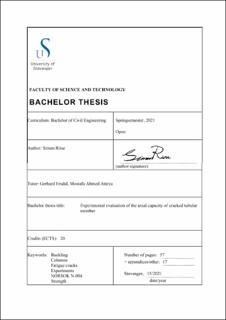| dc.contributor.advisor | Ersdal, Gerhard | |
| dc.contributor.advisor | Atteya, Mostafa Ahmed | |
| dc.contributor.author | Riise, Simen | |
| dc.date.accessioned | 2021-09-07T16:27:11Z | |
| dc.date.available | 2021-09-07T16:27:11Z | |
| dc.date.issued | 2021 | |
| dc.identifier | no.uis:inspera:78877253:34583638 | |
| dc.identifier.uri | https://hdl.handle.net/11250/2774295 | |
| dc.description.abstract | This thesis experimentally investigated the compressive axial capacity of cracked tubular
members. Then compared it to NORSOK N-004 (Standard Norge 2004) formulae. Further,
the test results were compared with other analytical models, such as non-linear finite element
analysis from a separate thesis (Vågen 2021) and basic column formulae e.g. Perry Robertson
and the Secant method.
In this study, 11 tubular columns were tested with a diameter of 70 mm, 2.9 mm thickness,
and 1.5 m height, due to the testing facilities limitation. Different crack sizes were placed
perpendicular to the loading direction with sizes corresponding to NORSOK N-004 reduced
capacity of 25, 50 and 75%. The material properties were obtained by stub column tests. To
further study the effect of cracks on tubular members, angled cracks with respect to the
loading direction were introduced to the stub column.
For the specimens with cracks perpendicular to the loading direction, The test results were
somewhat unexpected and showed an inconsiderable reduction in the axial capacity, as the
crack surfaces bear on each other. However, the angled cracks introduced to the stub columns
showed a considerable capacity reduction. The reduction is assumed to result from the crack
surface slipping, discontinuity in the material, and torsion due to the angled crack in the stub
column.
The conclusion was that angled cracks have the most significant impact on the compressive
axial capacity. On the other hand, cracks placed perpendicular to the loading direction had an
insignificant effect on the capacity. Hence, the NORSOK N-004 formulae provide inaccurate
formulas for capacity determination for such cases. Among the analytical methods presented
in this thesis, Perry Robertson gave the most accurate capacity. This result was somewhat
expected as the method was best adapted to the actual column behavior in the tests. | |
| dc.description.abstract | This thesis experimentally investigated the compressive axial capacity of cracked tubular
members. Then compared it to NORSOK N-004 (Standard Norge 2004) formulae. Further,
the test results were compared with other analytical models, such as non-linear finite element
analysis from a separate thesis (Vågen 2021) and basic column formulae e.g. Perry Robertson
and the Secant method.
In this study, 11 tubular columns were tested with a diameter of 70 mm, 2.9 mm thickness,
and 1.5 m height, due to the testing facilities limitation. Different crack sizes were placed
perpendicular to the loading direction with sizes corresponding to NORSOK N-004 reduced
capacity of 25, 50 and 75%. The material properties were obtained by stub column tests. To
further study the effect of cracks on tubular members, angled cracks with respect to the
loading direction were introduced to the stub column.
For the specimens with cracks perpendicular to the loading direction, The test results were
somewhat unexpected and showed an inconsiderable reduction in the axial capacity, as the
crack surfaces bear on each other. However, the angled cracks introduced to the stub columns
showed a considerable capacity reduction. The reduction is assumed to result from the crack
surface slipping, discontinuity in the material, and torsion due to the angled crack in the stub
column.
The conclusion was that angled cracks have the most significant impact on the compressive
axial capacity. On the other hand, cracks placed perpendicular to the loading direction had an
insignificant effect on the capacity. Hence, the NORSOK N-004 formulae provide inaccurate
formulas for capacity determination for such cases. Among the analytical methods presented
in this thesis, Perry Robertson gave the most accurate capacity. This result was somewhat
expected as the method was best adapted to the actual column behavior in the tests. | |
| dc.language | eng | |
| dc.publisher | uis | |
| dc.title | Experimental evaluation of the axial capacity of cracked tubular
member | |
| dc.type | Bachelor thesis | |
